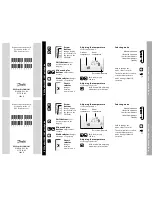
66
The recommended size of the power supply leads is 18AWG, but can be in the range of
12AWG to 18AWG. The wires are routed through the center conduit hole and are hooked
up to the power connector (see Figure 17 on page 63). The power leads are twisted
together to fit in the compartment formed by the wire shield and the back of the case.
5.6.2.1
Line Voltage Selection for Meter
Note: Misapplication of AC
line power to this
instrument can cause
damage to the instrument.
Prior to connection, verify
that the Volt Select Switch
is set for the proper AC
line requirement.
This instrument is factory set and properly fused for 115 Vac line requirements. To convert
the instrument for 230 Vac line requirements, proceed as follows:
1. Rotate the indicator slot on the Volt Select Switch to the 230 V position (see Figure 18
2. Remove the 0.2A fuses, and replace them with appropriate type 0.1A fuses (refer to
Section 8.3 Fuse Replacement).
5.6.3
Alarms
The alarm relays have unpowered contacts, and the power to operate the load is supplied
by the user. Figure 19 shows a typical wiring configuration. The wires must be sized
according to the load used. For the maximum 5A load, the wires must be a minimum
of 16 AWG.
The wires are routed through the left conduit hole (see Figure 17 on page 63), and are
hooked up to J5 on the front panel (see Figure 18 on page 64). Maximum voltage is
30Vrms (42.4V pk).
Figure 19
Typical Wiring Configuration
5.6.4
Recorder and Controller
The recorder and controller connections are isolated 4-20 mA outputs and should be
connected with twisted pair shielded cable. The shield wire should be connected at the
instrument end only.
Summary of Contents for EC1000
Page 2: ...2...
Page 8: ...8...
Page 12: ...12...
Page 14: ...14...
Page 16: ...16...
Page 18: ...18 Figure 1 Controller Front Panel...
Page 20: ...20 Figure 2 Pump Module...
Page 24: ...24 Figure 6 pH Control Loop...
Page 54: ...54...
Page 56: ...56...
Page 58: ...58 Figure 12 Controller Installation Panel Mount...
Page 61: ...61 Figure 15 Installing the pH ORP Electrode Figure 16 Flow Thru Cell...
Page 70: ...70...
Page 73: ...73 6 4 Calibration See Section 2 3 Calibration Figure 21 Priming Tee Operation...
Page 74: ...74...
Page 80: ...80...
Page 83: ...83 Figure 24 Sensor Replacement...
Page 85: ...85 Figure 25 Hach One pH Process Electrode...
Page 89: ...89 Figure 26 Pump Module Plumbing Diagram...
Page 102: ...102...
Page 103: ......
Page 104: ......
Page 105: ......
Page 106: ......
Page 108: ...108...
Page 112: ...112...
Page 116: ...116...
Page 122: ...122...
Page 123: ...123...
Page 124: ......
















































